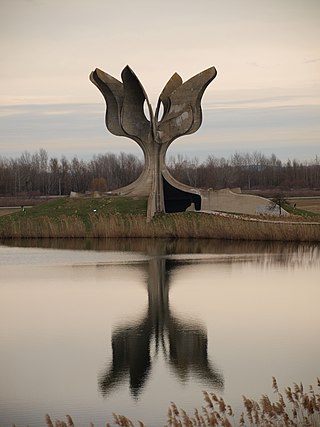
The Socialist Federal Republic of Yugoslavia (SFRY), commonly referred to as SFR Yugoslavia or Socialist Yugoslavia or simply as Yugoslavia, was a country in Central and Southeast Europe. It emerged in 1945, following World War II, and lasted until 1992, breaking up as a consequence of the Yugoslav Wars. Spanning an area of 255,804 square kilometres (98,766 sq mi) in the Balkans, Yugoslavia was bordered by the Adriatic Sea and Italy to the west, Austria and Hungary to the north, Bulgaria and Romania to the east, and Albania and Greece to the south. It was a one-party socialist state and federation governed by the League of Communists of Yugoslavia, and had six constituent republics: Bosnia and Herzegovina, Croatia, Macedonia, Montenegro, Serbia, and Slovenia. Within Serbia was the Yugoslav capital city of Belgrade as well as two autonomous Yugoslav provinces: Kosovo and Vojvodina.

Dušan Džamonja was a Yugoslav sculptor of Serbian ancestry.

The Yugoslav Partisans, or the National Liberation Army, officially the National Liberation Army and Partisan Detachments of Yugoslavia, was the communist-led anti-fascist resistance to the Axis powers in occupied Yugoslavia during World War II. Led by Josip Broz Tito, the Partisans are considered to be Europe's most effective anti-Axis resistance movement during World War II.

The League of Communists of Yugoslavia, known until 1952 as the Communist Party of Yugoslavia, was the founding and ruling party of SFR Yugoslavia. It was formed in 1919 as the main communist opposition party in the Kingdom of Serbs, Croats and Slovenes and after its initial successes in the elections, it was proscribed by the royal government and was at times harshly and violently suppressed. It remained an illegal underground group until World War II when, after the invasion of Yugoslavia in 1941, the military arm of the party, the Yugoslav Partisans, became embroiled in a bloody civil war and defeated the Axis powers and their local auxiliaries. After the liberation from foreign occupation in 1945, the party consolidated its power and established a one-party state, which existed in that form of government until 1990, a year prior to the start of the Yugoslav Wars and breakup of Yugoslavia.

The Socialist Republic of Macedonia, or SR Macedonia, commonly referred to as Socialist Macedonia, Yugoslav Macedonia or simply Macedonia, was one of the six constituent republics of the post-World War II Socialist Federal Republic of Yugoslavia, and a nation state of the Macedonians. After the transition of the political system to parliamentary democracy in 1990, the Republic changed its official name to Republic of Macedonia in 1991, and with the beginning of the breakup of Yugoslavia, it declared itself an independent country and held a referendum on 8 September 1991 on which a sovereign and independent state of Macedonia, with a right to enter into any alliance with sovereign states of Yugoslavia was approved.

The Order of the People's Hero or the Order of the National Hero, was a Yugoslav gallantry medal, the second highest military award, and third overall Yugoslav decoration. It was awarded to individuals, military units, political and other organisations who distinguished themselves by extraordinary heroic deeds during war and in peacetime. The recipients were thereafter known as People's Heroes of Yugoslavia or National Heroes of Yugoslavia. The vast majority was awarded to partisans for actions during the Second World War. A total of 1,322 awards were awarded in Yugoslavia, and 19 were awarded to foreigners.

Lazar Koliševski was a Macedonian Yugoslav communist political leader in the Socialist Republic of Macedonia and briefly in the Socialist Federal Republic of Yugoslavia. He was closely allied with Josip Broz Tito.

World War II in the Kingdom of Yugoslavia began on 6 April 1941, when the country was invaded and swiftly conquered by Axis forces and partitioned among Germany, Italy, Hungary, Bulgaria and their client regimes. Shortly after Germany attacked the USSR on 22 June 1941, the communist-led republican Yugoslav Partisans, on orders from Moscow, launched a guerrilla liberation war fighting against the Axis forces and their locally established puppet regimes, including the Axis-allied Independent State of Croatia (NDH) and the Government of National Salvation in the German-occupied territory of Serbia. This was dubbed the National Liberation War and Socialist Revolution in post-war Yugoslav communist historiography. Simultaneously, a multi-side civil war was waged between the Yugoslav communist Partisans, the Serbian royalist Chetniks, the Axis-allied Croatian Ustaše and Home Guard, Serbian Volunteer Corps and State Guard, Slovene Home Guard, as well as Nazi-allied Russian Protective Corps troops.

The Macedonian Partisans, officially the National Liberation Army and Partisan Detachments of Macedonia, was a communist and anti-fascist resistance movement formed in occupied Yugoslavia which was active in World War II in Yugoslav Macedonia. Units of the army were formed by Macedonians within the framework of the Yugoslav Partisans as well as other communist resistance organisations operating in Macedonia at the time and were led by the General Staff of the National Liberation Army and Partisan Detachments of Macedonia, headed by Mihajlo Apostolski.
The 1963 Skopje earthquake was a 6.1 moment magnitude earthquake which occurred in Skopje, SR Macedonia, then part of the SFR Yugoslavia, on July 26, 1963, which killed over 1,070 people, injured between 3,000 and 4,000 and left more than 200,000 people homeless. About 80 percent of the city was destroyed.

World War II in Yugoslav Macedonia started with the Axis invasion of Yugoslavia in April 1941. Under the pressure of the Yugoslav Partisan movement, part of the Macedonian communists began in October 1941 a political and military campaign to resist the occupation of Vardar Macedonia. Officially, the area was called then Vardar Banovina, because the very name Macedonia was prohibited in the Kingdom of Yugoslavia. It was occupied mostly by Bulgarian, but also by German, Italian, and Albanian forces.

The authorities of the Socialist Federal Republic of Yugoslavia established many World War II memorials during its existence. Several memorial sites were established between 1945 and 1960, though widespread building started after the founding of the Non-Aligned Movement.

Monument to the revolutionary victory of the people of Slavonia or Monument to the people-hero of Slavonia was a World War II memorial sculpture by Vojin Bakić, that was located in, now uninhabited, Serbian village of Kamenska, Brestovac, Slavonia, Croatia. It was destroyed by the Armed Forces of Croatia in 1992.

Miodrag Živković was a Serbian sculptor and university professor. He is well-known for his work on memorial complexes throughout Yugoslavia.

Day of the Macedonian Uprising is a public holiday in North Macedonia, commemorating what is considered there as the beginning of the communist resistance against fascism during World War II in Yugoslav Macedonia, on October 11.

The architecture of Yugoslavia was characterized by emerging, unique, and often differing national and regional narratives. As a socialist state remaining free from the Iron Curtain, Yugoslavia adopted a hybrid identity that combined the architectural, cultural, and political leanings of both Western liberal democracy and Soviet communism.














































